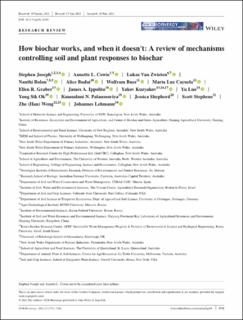| dc.description.abstract | We synthesized 20 years of research to explain the interrelated processes that determine soil and plant responses to biochar. The properties of biochar and its effects within agricultural ecosystems largely depend on feedstock and pyrolysis conditions. We describe three stages of reactions of biochar in soil: dissolution (1–3 weeks); reactive surface development (1–6 months); and aging (beyond 6 months). As biochar ages, it is incorporated into soil aggregates, protecting the biochar carbon and promoting the stabilization of rhizodeposits and microbial products. Biochar carbon persists in soil for hundreds to thousands of years. By increasing pH, porosity, and water availability, biochars can create favorable conditions for root development and microbial functions. Biochars can catalyze biotic and abiotic reactions, particularly in the rhizosphere, that increase nutrient supply and uptake by plants, reduce phytotoxins, stimulate plant development, and increase resilience to disease and environmental stressors. Meta-analyses found that, on average, biochars increase P availability by a factor of 4.6; decrease plant tissue concentration of heavy metals by 17%–39%; build soil organic carbon through negative priming by 3.8% (range −21% to +20%); and reduce non-CO2 greenhouse gas emissions from soil by 12%–50%. Meta-analyses show average crop yield increases of 10%–42% with biochar addition, with greatest increases in low-nutrient P-sorbing acidic soils (common in the tropics), and in sandy soils in drylands due to increase in nutrient retention and water holding capacity. Studies report a wide range of plant responses to biochars due to the diversity of biochars and contexts in which biochars have been applied. Crop yields increase strongly if site-specific soil constraints and nutrient and water limitations are mitigated by appropriate biochar formulations. Biochars can be tailored to address site constraints through feedstock selection, by modifying pyrolysis conditions, through pre- or post-production treatments, or co-application with organic or mineral fertilizers. We demonstrate how, when used wisely, biochar mitigates climate change and supports food security and the circular economy. | en_US |

